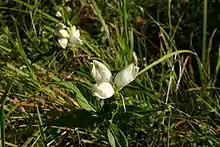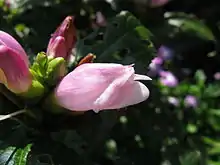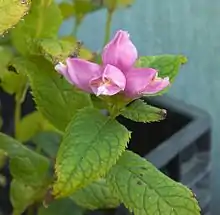Chelone (plant)
Chelone is a genus of four[1] species of perennial herbaceous plants native to eastern North America.[1][2] They all have similarly shaped flowers (which led to the name turtlehead due to their resemblance to the head of a turtle), which vary in color from white to red, purple or pink.[1] Chelone cuthbertii, C. glabra, and C. lyonii are diploid and C. obliqua is either tetraploid or hexaploid, depending on their slight differences in morphology and localities.[1]
| Chelone | |
|---|---|
 | |
| Chelone glabra | |
| Scientific classification | |
| Kingdom: | Plantae |
| Clade: | Tracheophytes |
| Clade: | Angiosperms |
| Clade: | Eudicots |
| Clade: | Asterids |
| Order: | Lamiales |
| Family: | Plantaginaceae |
| Tribe: | Cheloneae |
| Genus: | Chelone L. |
| Species | |
| |


Relationships to other plants
The closest relative of Chelone is Nothochelone from western North America.[1] [3] [6] Nothochelone nemerosa is the species most closely related to the genus [3] [6]. Chelone is more closely related to it than to other members of the family such as snapdragons, plantains, and foxglove.[3]
Species
Chelone cuthbertii is found in two areas: the Blue Ridge of North Carolina and the coastal plain of Virginia.[1] [5] [6]
Chelone glabra is the most widely distributed species of the genus: from Georgia to Newfoundland and from Mississippi to Manitoba;[4] [5] [6] the other three are found in more restricted areas.
Chelone lyonii is found in the Blue Ridge of Tennessee, North Carolina, and South Carolina.[1] [5] [6]
Chelone obliqua is found as tetraploids in the Blue Ridge, or hexaploids in two areas: Tennessee to Arkansas and Michigan, or the Atlantic coastal plain from South Carolina to Maryland.[1] [5] [6]
The relationship between the different populations is complicated and it appears that C. obliqua in fact has arisen several times from diploid ancestors of the other three species.[1] [5] [6] The four species seem to have diverged recently.[1] [5] [6]
References
- Allan D. Nelson; Wayne J. Elisens (1999). "Polyploid evolution and biogeography in Chelone (Scrophulariaceae): morphological and isozyme evidence". American Journal of Botany. Botanical Society of America. 86 (10): 1487–1501. doi:10.2307/2656929. JSTOR 2656929. PMID 10523288.
- "Chelone". Natural Resources Conservation Service PLANTS Database. USDA.
- Olmstead, R. G.; dePamphilis, C. W.; Wolfe, A. D.; Young, N. D.; Elisons, W. J. & Reeves P. A. (2001). "Disintegration of the Scrophulariaceae". American Journal of Botany. Botanical Society of America. 88 (2): 348–361. doi:10.2307/2657024. JSTOR 2657024. PMID 11222255.
- "Chelone glabra". Natural Resources Conservation Service PLANTS Database. USDA.
- A. D. Nelson. 2012. Chelone. Flora of North America http://floranorthamerica.org/files/Chelone03f.CH%20for%20Prov%20Pub.pdf
- NELSON, A.D. 1995. Polyploid evolution in Chelone (Scrophulariaceae). Ph.D. dissertation, University of. Oklahoma, Norman.
- Chelone L. Plants of the World Online
- Accepted species Plants of the World Online